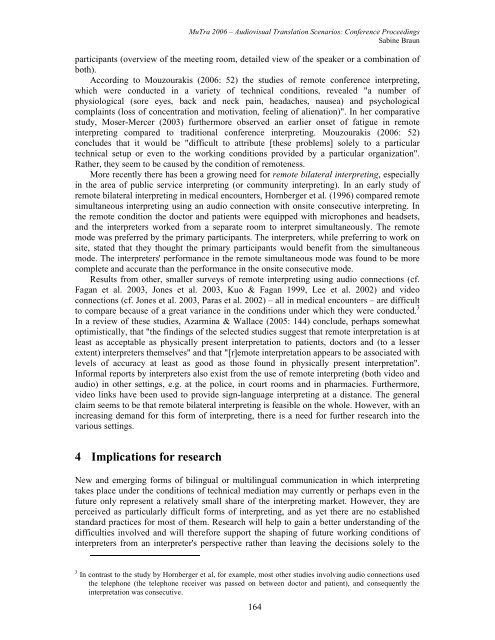Proceedings - Translation Concepts
Proceedings - Translation Concepts
Proceedings - Translation Concepts
Create successful ePaper yourself
Turn your PDF publications into a flip-book with our unique Google optimized e-Paper software.
MuTra 2006 – Audiovisual <strong>Translation</strong> Scenarios: Conference <strong>Proceedings</strong><br />
Sabine Braun<br />
participants (overview of the meeting room, detailed view of the speaker or a combination of<br />
both).<br />
According to Mouzourakis (2006: 52) the studies of remote conference interpreting,<br />
which were conducted in a variety of technical conditions, revealed "a number of<br />
physiological (sore eyes, back and neck pain, headaches, nausea) and psychological<br />
complaints (loss of concentration and motivation, feeling of alienation)". In her comparative<br />
study, Moser-Mercer (2003) furthermore observed an earlier onset of fatigue in remote<br />
interpreting compared to traditional conference interpreting. Mouzourakis (2006: 52)<br />
concludes that it would be "difficult to attribute [these problems] solely to a particular<br />
technical setup or even to the working conditions provided by a particular organization".<br />
Rather, they seem to be caused by the condition of remoteness.<br />
More recently there has been a growing need for remote bilateral interpreting, especially<br />
in the area of public service interpreting (or community interpreting). In an early study of<br />
remote bilateral interpreting in medical encounters, Hornberger et al. (1996) compared remote<br />
simultaneous interpreting using an audio connection with onsite consecutive interpreting. In<br />
the remote condition the doctor and patients were equipped with microphones and headsets,<br />
and the interpreters worked from a separate room to interpret simultaneously. The remote<br />
mode was preferred by the primary participants. The interpreters, while preferring to work on<br />
site, stated that they thought the primary participants would benefit from the simultaneous<br />
mode. The interpreters' performance in the remote simultaneous mode was found to be more<br />
complete and accurate than the performance in the onsite consecutive mode.<br />
Results from other, smaller surveys of remote interpreting using audio connections (cf.<br />
Fagan et al. 2003, Jones et al. 2003, Kuo & Fagan 1999, Lee et al. 2002) and video<br />
connections (cf. Jones et al. 2003, Paras et al. 2002) – all in medical encounters – are difficult<br />
to compare because of a great variance in the conditions under which they were conducted. 3<br />
In a review of these studies, Azarmina & Wallace (2005: 144) conclude, perhaps somewhat<br />
optimistically, that "the findings of the selected studies suggest that remote interpretation is at<br />
least as acceptable as physically present interpretation to patients, doctors and (to a lesser<br />
extent) interpreters themselves" and that "[r]emote interpretation appears to be associated with<br />
levels of accuracy at least as good as those found in physically present interpretation".<br />
Informal reports by interpreters also exist from the use of remote interpreting (both video and<br />
audio) in other settings, e.g. at the police, in court rooms and in pharmacies. Furthermore,<br />
video links have been used to provide sign-language interpreting at a distance. The general<br />
claim seems to be that remote bilateral interpreting is feasible on the whole. However, with an<br />
increasing demand for this form of interpreting, there is a need for further research into the<br />
various settings.<br />
4 Implications for research<br />
New and emerging forms of bilingual or multilingual communication in which interpreting<br />
takes place under the conditions of technical mediation may currently or perhaps even in the<br />
future only represent a relatively small share of the interpreting market. However, they are<br />
perceived as particularly difficult forms of interpreting, and as yet there are no established<br />
standard practices for most of them. Research will help to gain a better understanding of the<br />
difficulties involved and will therefore support the shaping of future working conditions of<br />
interpreters from an interpreter's perspective rather than leaving the decisions solely to the<br />
3 In contrast to the study by Hornberger et al, for example, most other studies involving audio connections used<br />
the telephone (the telephone receiver was passed on between doctor and patient), and consequently the<br />
interpretation was consecutive.<br />
164
















